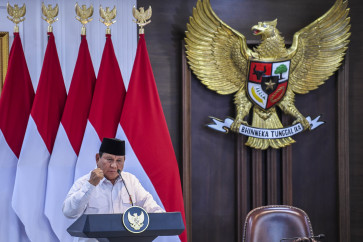Popular Reads
Top Results
Can't find what you're looking for?
View all search resultsPopular Reads
Top Results
Can't find what you're looking for?
View all search resultsRomance comics of the 60s: A short lived love story
Courtesy of Hikmat Darmawan A scene from Tertiup Bersama Angin, one of the most prominent Indonesian romance comics of the 1960s, shows Alec, a rugged man with thick eyebrows, dejectedly covering his forehead with his hairy left hand
Change text size
Gift Premium Articles
to Anyone
Courtesy of Hikmat Darmawan
A scene from Tertiup Bersama Angin, one of the most prominent Indonesian romance comics of the 1960s, shows Alec, a rugged man with thick eyebrows, dejectedly covering his forehead with his hairy left hand.
A beautiful woman, Inge, tries to console him, holding his arm. “Listen Inge, you don’t know who I am. Get away from me,” Alec says.
Determined to have him, Inge replies, “I know who you are, Alec. You are a man who surrenders only to tenderness and is undeterred by ferocity.”
The comic is just one from the era’s romance genre, which were avidly consumed by women and men alike, at a time when youth culture was swamped by feelings tenderness, love and heartbreak.
Although Tertiup Bersama Angin seems to take place in a highly developed city like New York, Paris or London, its creator, Jan Mintaraga, says the setting was Jakarta in the late 1960s, just after the fall of the anti-West president Sukarno and the rise of the pro-West president Soeharto.
To emphasize his leaning, Jan gave the comic the title, which a direct translation of Bob Dylan’s 1962 song Blowin with the Wind. The desperation of love is well described by the first verse of the song.
“Romance comics are the most loyal comic to the idea of modern Jakarta. Maybe because the city is a space for dreaming, love and longing,” Hikmat Darmawan, a cultural expert, said.
“The pictures they paint were not the true condition of Jakarta, but the mental image of what the creators wanted to see in Jakarta, the dream of Jakarta. These comics perhaps have contributed to shape of the current Jakarta,” he remarked.

Along with other comic writers like Zaldy and Zair Warni, Jan illustrates the idea and desire to ‘go West’, something forbidden during the Sukarno era.
The beautiful characters not only have western names but also follow western trends; men are depicted wearing two-piece suits and greased hair and women sport bouffant hairdos.
Scenes in which characters read books and newspapers are something of a must for the comics, even though most people at that time were illiterate and love for books was something found only within the small circle of the upper class.
The comics always show characters living in brick houses with fluffy sofas, vinyl records of hip western songs and the must have abstract paintings on the walls. Radio transistors, a sign of wealth at that time, are seen in the rooms, along with shelves of books and piles of newspaper. The active night-lives portrayed were a sign of modernity; wealth was equated with happiness.
There is almost no room for poor people, despite the reality of widespread poverty outside the pages of the comics.
“Not only are the poor removed from the scenes, as castaways; when they are included, they are made to bear guilt. In one story , an old lady was poor because she cheated a man before. Her daughter ended up with the man’s son and the last scene showed that they were happily sitting on a plane. Happiness is strongly linked to wealth,” Hikmat said.
But unlike the movies produced in the following years, the stories could have happened anywhere, as the background does not pinpoint any of Jakarta’s landmarks.
“This is perhaps because the landmarks were not there yet and were only built in the following years by Jakarta governor Ali Sadikin. It is of course not all imagination. They are linked to the lives of a few high class people. But only a few had that kind of life,” Hikmat remarked.

Although the illustrations exaggerate lifestyles, they take care to adhere to concepts of space and perspective. Shadows are drawn according to the lighting present and backgrounds are detailed as the writers of these comic were mostly trained artists.
By the early 1970s, however, the mostly male readership had had enough of reading about the love and heartache that entangled the lives of these beautiful city people and abandoned them as soon as the first martial art comic Si Buta dari Goa Hantu was published by Ganes TH.
Just like the characters, who are more often than not entangled in love triangles or suffer from unrequited love, romance was soon left for macho fighting and tales of superheroes. Comic writers moved to the new genre and the ‘romance master’ Zaldy, said to be dejected by the comic industry, retired.
“Just like the dream of city that is often crashed by the picture of reality, the picture of love too is often crashed by the reality of life,” Hikmat wrote in his paper .
Today it is hard to find even traces of these comics. Some dedicated collectors still have them stored away safely, or if you are lucky, you might chance upon one at a second-hand book stalls.
More than four decades later, does Jakarta still dream?
More information on the history of comics in Indonesia can be accessed at www.karbonjournal.org










